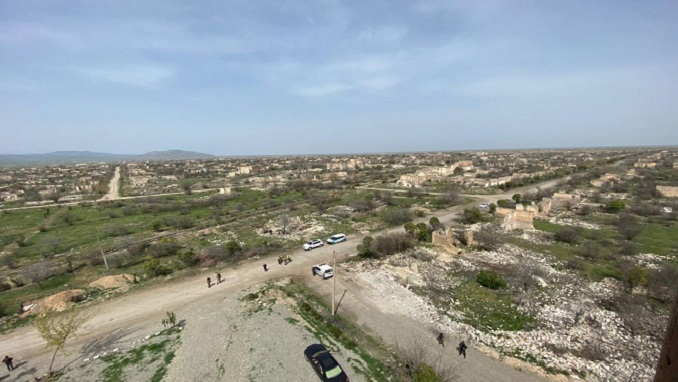Numerous buildings in Azerbaijan’s liberated territories were destroyed, Permanent Representative to the OIC from Afghanistan, Shafiq Samim said. Samim made the statement at a press conference dedicated to the results of the visits of the OIC Contact Group’s delegation to the liberated Aghdam district, as well as Ganja city, Trend reports.
“In Aghdam, all settlements and mosques were destroyed. Besides, during our visit to Ganja, we saw the consequences of the bombing of civilians during the war,” he said.
According to the representative, before and during the war, Azerbaijan’s President Ilham Aliyev informed the world about the aggression of Armenia against the Azerbaijani people. “We support the president’s position. I’ll make efforts to spread information about what I saw in the Afghan media,” added Samim.
We saw great destruction in the territories of Azerbaijan liberated from Armenian occupation, Deputy Ambassador of the Gambia to the OIC, Abu Bakr Jah said.
“In the liberated territories of Azerbaijan, we saw destroyed mosques, everything was ruined. Attempts were made to completely destroy life here, but this was not achieved. Life will be restored, here again, people will return to their homes,” he said.
The deputy ambassador said that the perpetrators of crimes committed in the territories of Azerbaijan must answer before international justice.
Armenia has committed crimes against humanity, against the environment, Malaysian Ambassador to Azerbaijan Dato Yubazlan Bin Yusof said.
“We have witnessed the consequences of the crimes committed by Armenia during the occupation of the territories of Azerbaijan. These are crimes against humanity,” he said.
Meanwhile, normalizing the situation in Karabakh remains the most relevant and acute issue, Russian President Vladimir Putin said at a meeting with Armenian Prime Minister Nikol Pashinyan.
“Of course, we also have to talk about building bilateral relations, and normalization of the situation in Nagorno-Karabakh and around it,” Putin said.
Following the 44-day war (from late Sept. through early Nov.2020) between Armenia and Azerbaijan, a joint statement to end the war was made by the Azerbaijani president, Armenia’s PM, and the president of Russia. As a result of the war Azerbaijan liberated its territories from the Armenian occupation.
A complete ceasefire and a cessation of all hostilities in the zone of the Nagorno-Karabakh conflict were introduced on Nov. 10, 2020.
The conflict between the two South Caucasus countries began in 1988 when Armenia made territorial claims against Azerbaijan. As a result of the ensuing war, the Armenian Armed Forces occupied 20 percent of Azerbaijan, including the Nagorno-Karabakh region and seven surrounding districts. The 1994 ceasefire agreement was followed by peace negotiations.
Following over a month of military action to liberate its territories from Armenian occupation from late Sept. to early Nov. 2020, Azerbaijan has pushed Armenia to sign the surrender document. A joint statement on the matter was made by the Azerbaijani president, Armenia’s PM, and the president of Russia.
Armenian Armed Forces launched a large-scale military attack on positions of the Azerbaijani army on the front line, using large-caliber weapons, mortars, and artillery on Sept. 27. Azerbaijan responded with a counter-offensive along the entire front.
Back in July 2020, the Armenian Armed Forces violated the ceasefire in the direction of Azerbaijan’s Tovuz district. As a result of Azerbaijan’s retaliation, the opposing forces were silenced. The fighting continued the following days. Azerbaijan lost a number of military personnel members, who died fighting off the attacks of the Armenian Armed Forces.
The conflict between the two South Caucasus countries began in 1988 when Armenia made territorial claims against Azerbaijan. As a result of the ensuing war, the Armenian Armed Forces occupied 20 percent of Azerbaijan, including the Nagorno-Karabakh region and seven surrounding districts. The 1994 ceasefire agreement was followed by peace negotiations.
